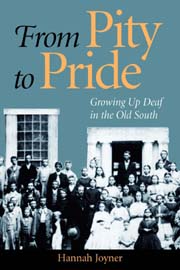Growing Up Deaf in the Old South
Hannah Joyner
|
Read chapter seven. Read reviews: Choice, Daily News, Disability Studies Quarterly, The Journal of American History, The Journal of Southern History. |
$57.50s print edition $57.50 e-book |
From The Journal of American History
In the past two decades, a growing number of social historians have provided increasingly complex portraits of the individual and shared experiences of the nation’s Deaf citizens in the nineteenth and twentieth centuries. In From Pity to Pride, the historian Hannah Joyner offers a carefully considered and well-documented study that centers on the education and coming of age of several prominent white Deaf men in the antebellum South.
Deaf adults in the decades before the Civil War, Joyner explains, faced formidable cultural obstacles. Most southern hearing elites as well as educators depicted deafness as a grave deficiency. Deprived of hearing and, by all accounts, the ability readily to acquire spoken language, Deaf children, according to this view, were separated from family, society—indeed, their very humanity.
Despite these barriers, hearing adults, joined by a growing corps of Deaf adults, built an impressive network of private and state-supported residential schools—where sign language emerged as the preeminent means of instruction and communication. Other authors have ably summarized this pivotal historical era and development. Joyner’s synthesis, if not groundbreaking, is extremely engaging. In particular, readers will appreciate her astute use of varied primary documents and personal letters from teachers and administrators at selected schools and from the prominent Tillinghast family of North Carolina.
Her profiles of the education and maturation of the brothers Thomas and David Tillinghast are especially discerning. In one example, she cites a brief letter sent by eight-year-old Thomas to his parents: “I am well. I hope that you are well. I like to learn very much. The deaf and dumb are well” (p. 89). Thomas’s inexpert use of written English, explained Joseph Tyler, principal of the Virginia school, was counterbalanced by his facility in sign language. “By the sign language,” Tyler counseled, Thomas had learned “an endless variety of things of which he knew nothing before” (p. 90). Thomas’s brother David boarded, not at Virginia, but at the New York school. Much to the chagrin of his family, David, over time, came to question his family’s slaveholding. Following the Civil War, however, David returned to North Carolina, where, supported by Deaf friends and relatives, he went on to a successful career as a teacher at the school in Raleigh.
For the Tillinghasts and countless other students, American Sign Language (ASL), Joyner explains, “offered Deaf people an escape from the struggles their deafness caused in hearing America”; in this way, she notes, ASL “was the grammar of liberation” (p. 101). “Rather than seeking charity,” these Deaf leaders, Joyner points out, sought “self determination and community”; rejecting the main stream portrayal of “deafness as a source of pity,” these adults, she concludes, “construed it to be a source of pride” (p. 3). This sophisticated study will be appreciated by general readers and respected by scholars with interests in education, sign language, family history, and the ascension of a national Deaf community.
Hannah Joyner is an independent historian in Takoma Park, MD.
Print Edition: ISBN 978-1-56368-270-4, 6 x 9 casebound, 224 pages, references, index
$57.50s
E-Book: ISBN 978-1-56368-316-9
$57.50
To order by mail, print our Order Form or call:TEL 1-800-621-2736; (773) 568-1550 8 am - 5 pm CST
TTY 1-888-630-9347
FAX 1-800-621-8476; (773) 660-2235
